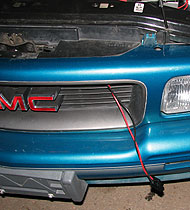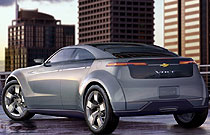|
By accessing/using The Crittenden Automotive Library/CarsAndRacingStuff.com, you signify your agreement with the Terms of Use on our Legal Information page. Our Privacy Policy is also available there. |

Electric Car Advocates Devise Their Own Plug-in Cars
|
|---|
|
|
Electric Car Advocates Devise Their Own Plug-in Cars
Shelley Schlender
Boulder, Colorado
Voice of America
April 11, 2007
 Listen to Electric Car Advocates Devise Their Own Plug-in Cars - MP3 - 1.0MB - 4:48
Listen to Electric Car Advocates Devise Their Own Plug-in Cars - MP3 - 1.0MB - 4:48
 Listen to Electric Car Advocates Devise Their Own Plug-in Cars - RealPlayer - 702KB - 4:48
Listen to Electric Car Advocates Devise Their Own Plug-in Cars - RealPlayer - 702KB - 4:48
As concerns about global warming and fossil fuel consumption rise, some of the world's biggest carmakers are designing more energy efficient, plug-in cars that can get power from electrical outlets and run on non-polluting batteries. Industry watchers estimate that these plug-in cars will be widely available within the decade. But many consumers, like Pete Rodgers, want them now, and have gotten them.
 Pete Rodgers' plug-in truck and its plug Pete Rodgers' plug-in truck and its plug
 Pete Rodgers, with his wife and cat, in front of his house, with solar panels visible on the roof. Pete Rodgers, with his wife and cat, in front of his house, with solar panels visible on the roof.
 Golf cart batteries power Rodgers' truck Golf cart batteries power Rodgers' truck
 Former GM consultant Chelsea Sexton now leads a public campaign for electric and alternative fuel vehicles Former GM consultant Chelsea Sexton now leads a public campaign for electric and alternative fuel vehicles
 General Motors unveiled the Chevrolet Volt, the company's first plug-in hybrid vehicle, at the 2007 Auto Show in Detroit General Motors unveiled the Chevrolet Volt, the company's first plug-in hybrid vehicle, at the 2007 Auto Show in Detroit
|
The Boulder, Colorado, veterinarian is the proud new owner of an all-electric pickup truck. He makes house calls to treat his patients, and says the truck's 100-kilometer range easily covers his daily rounds. And, he adds, it's as quiet as his family cat. "He makes the same sound as the electric car running. Just a very light purr."
To recharge the vehicle, he plugs it in overnight. "Basically, it just has a cord," he explains with a laugh. "This isn't rocket science. You have a cord and you plug your car in and it charges." He says this car reduces his use of fossil fuels and his contribution to global warming.
Rodgers' decision is even greener thanks to his rooftop solar panels. "It will be charged at night at the home, using the energy that's come in during the day from the sun."
The automotive industry doesn't make this vehicle. So Rodgers went to a local auto shop called Nobomotors that replaced his truck's gas engine with an electric one. The 24 golf cart batteries under the truck bed provide the power.
In the 1990s, General Motors produced a limited number of all-electric, plug-in cars with a range that's similar to Rodgers' truck. But before they became widely available, company officials decided to stop production. They recalled the roughly 1,000 electric cars … and crushed them.
A 2006 documentary, called Who Killed the Electric Car?, explores the reasons behind the move. Chelsea Sexton stars in the documentary. "I sort of was the automotive insider for the film," she explains, "and later became a bit of an activist trying to save the cars." Today, she leads the electric car advocacy group, Plug In America. "I want to see cars back on the road. I want to see them built by the independent folks who aren't going to wait for Detroit to do it."
She's visiting some of those "independent folks" in Boulder at Hybrids Plus, to see if the small auto shop can help with her mission.
At first glance, most of the cars on their lot look like any other Toyota Prius, the best-selling hybrid in the world. The gas-powered vehicle with a supplemental electric engine gets around 21 kilometers per liter. That's pretty efficient, but Sexton says Hybrids Plus is making these cars even better. The company is adding the ability to charge the engine, by plugging it in to an electric outlet in the owner's home, creating a versatile driving machine.
"[That's] one car that has a certain amount of all-electric range and also a backup hybrid system for when you need to go long distances," she says. "So Monday through Friday, all electric, and on the weekend, you have the best of both worlds." Thanks to a lithium battery, the converted cars from Hybrids Plus are capable of covering 50 kilometers with non-polluting, quiet, electric power. When running in a blended mode, using gasoline and electricity, the vehicles get over 42 kilometers per liter.
The lithium battery packs that provide the electric power are so new, right now, they must be made by hand. That's a big reason why converting a Prius to a plug-in currently costs more than the car itself. But Dave Turock, who has purchased a conversion, says that encouraging this technology is worth the money. "If people would drive these plug-in hybrids, we could virtually eliminate the oil that America purchases from the Middle East. And at the very least, it's going to clean up the environment. It's a good thing from many dimensions, and it's something that's here now."
But you won't see these vehicles on any car dealer's lot. As Tom Turrentine, Director of the Plug-in Hybrid Center at UC Davis in California explains, traditional automakers are often slow to adopt new ideas. "They may modify the shape of a fender or maybe change the engine's design a little bit. But oftentimes, they don't make that big of changes, quickly." He says small shops, like Hybrids Plus and Nobomotors, have proven the concept works, and are challenging Detroit to move faster. "That's probably accelerated things by five or six years," he estimates.
In fact, GM -- the company that crushed electric cars -- is planning two new models that can be filled with gas or plugged in. The Chevy Volt is scheduled to ship in 2010. Project Manager Tony Pasowatz says the company needs that time to scale up production.
Chelsea Sexton says the Volt looks great, but with time on her mind, she's recommending cars like these at Hybrids Plus. "We can't afford to wait. It takes at least 10 years to turn over the vehicle fleet in this country. All the more reason we have to start today."
Meanwhile, the federal government has just proposed $28 million for the promotion of plug-in technologies, and California-based Tesla Motors has introduced a high-performance, luxury all-electric sports car.


















 Listen to Electric Car Advocates Devise Their Own Plug-in Cars - MP3 - 1.0MB - 4:48
Listen to Electric Car Advocates Devise Their Own Plug-in Cars - MP3 - 1.0MB - 4:48
 Listen to Electric Car Advocates Devise Their Own Plug-in Cars - RealPlayer - 702KB - 4:48
Listen to Electric Car Advocates Devise Their Own Plug-in Cars - RealPlayer - 702KB - 4:48
 Pete Rodgers' plug-in truck and its plug
Pete Rodgers' plug-in truck and its plug
 Pete Rodgers, with his wife and cat, in front of his house, with solar panels visible on the roof.
Pete Rodgers, with his wife and cat, in front of his house, with solar panels visible on the roof.
 Golf cart batteries power Rodgers' truck
Golf cart batteries power Rodgers' truck
 Former GM consultant Chelsea Sexton now leads a public campaign for electric and alternative fuel vehicles
Former GM consultant Chelsea Sexton now leads a public campaign for electric and alternative fuel vehicles
 General Motors unveiled the Chevrolet Volt, the company's first plug-in hybrid vehicle, at the 2007 Auto Show in Detroit
General Motors unveiled the Chevrolet Volt, the company's first plug-in hybrid vehicle, at the 2007 Auto Show in Detroit
